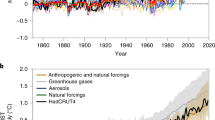Abstract.
A multi-fingerprint analysis is applied to the detection and attribution of anthropogenic climate change. While a single fingerprint is optimal for the detection of climate change, further tests of the statistical consistency of the detected climate change signal with model predictions for different candidate forcing mechanisms require the simultaneous application of several fingerprints. Model-predicted climate change signals are derived from three anthropogenic global warming simulations for the period 1880 to 2049 and two simulations forced by estimated changes in solar radiation from 1700 to 1992. In the first global warming simulation, the forcing is by greenhouse gas only, while in the remaining two simulations the direct influence of sulfate aerosols is also included. From the climate change signals of the greenhouse gas only and the average of the two greenhouse gas-plus-aerosol simulations, two optimized fingerprint patterns are derived by weighting the model-predicted climate change patterns towards low-noise directions. The optimized fingerprint patterns are then applied as a filter to the observed near-surface temperature trend patterns, yielding several detection variables. The space-time structure of natural climate variability needed to determine the optimal fingerprint pattern and the resultant signal-to-noise ratio of the detection variable is estimated from several multi-century control simulations with different CGCMs and from instrumental data over the last 136 y. Applying the combined greenhouse gas-plus-aerosol fingerprint in the same way as the greenhouse gas only fingerprint in a previous work, the recent 30-y trends (1966–1995) of annual mean near surface temperature are again found to represent a significant climate change at the 97.5% confidence level. However, using both the greenhouse gas and the combined forcing fingerprints in a two-pattern analysis, a substantially better agreement between observations and the climate model prediction is found for the combined forcing simulation. Anticipating that the influence of the aerosol forcing is strongest for longer term temperature trends in summer, application of the detection and attribution test to the latest observed 50-y trend pattern of summer temperature yielded statistical consistency with the greenhouse gas-plus-aerosol simulation with respect to both the pattern and amplitude of the signal. In contrast, the observations are inconsistent with the greenhouse-gas only climate change signal at a 95% confidence level for all estimates of climate variability. The observed trend 1943–1992 is furthermore inconsistent with a hypothesized solar radiation change alone at an estimated 90% confidence level. Thus, in contrast to the single pattern analysis, the two pattern analysis is able to discriminate between different forcing hypotheses in the observed climate change signal. The results are subject to uncertainties associated with the forcing history, which is poorly known for the solar and aerosol forcing, the possible omission of other important forcings, and inevitable model errors in the computation of the response to the forcing. Further uncertainties in the estimated significance levels arise from the use of model internal variability simulations and relatively short instrumental observations (after subtraction of an estimated greenhouse gas signal) to estimate the natural climate variability. The resulting confidence limits accordingly vary for different estimates using different variability data. Despite these uncertainties, however, we consider our results sufficiently robust to have some confidence in our finding that the observed climate change is consistent with a combined greenhouse gas and aerosol forcing, but inconsistent with greenhouse gas or solar forcing alone.
Similar content being viewed by others
Author information
Authors and Affiliations
Additional information
Received: 28 April 1996 / Accepted: 27 January 1997
Rights and permissions
About this article
Cite this article
Hegerl, G., Hasselmann, K., Cubasch, U. et al. Multi-fingerprint detection and attribution analysis of greenhouse gas, greenhouse gas-plus-aerosol and solar forced climate change. Climate Dynamics 13, 613–634 (1997). https://doi.org/10.1007/s003820050186
Issue Date:
DOI: https://doi.org/10.1007/s003820050186




